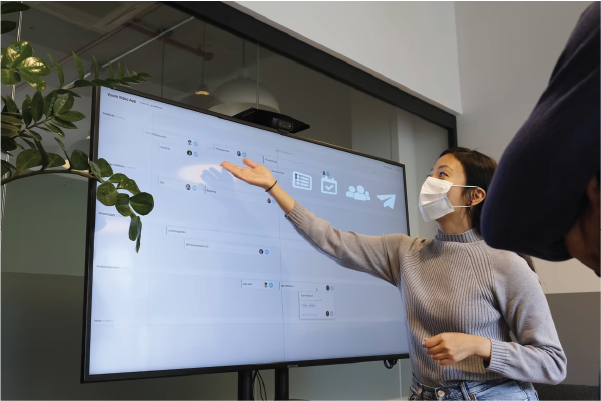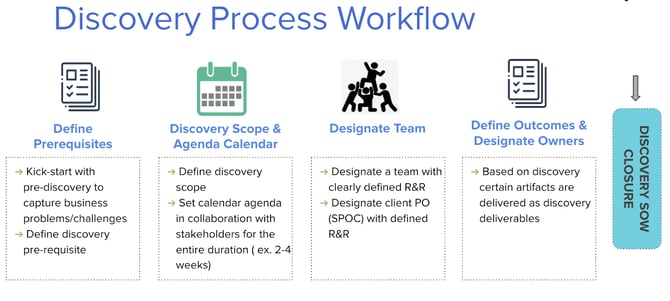After putting in an insane amount of time and work on a discovery proposal, you don’t want to hear a “no”.
To convert your prospects into clients, your proposal needs a high level understanding of the client’s business, take the guesswork out of things and most importantly focus on the problems they are facing or may face in near future.
This blog will shed light on factors essential for designing an effective proposal and also the basic concepts of the software project discovery phase.
What is Software Project Discovery?Similar to what discovery means for a layman, in business, it loosely translates to gathering and analyzing the information about a new product/software to help understand its goals, vision, scope, limitations, usage by involving key stakeholders. It helps understand the needs of the business upfront, challenges associated, and budgeting. |
Why does Discovery matter?
A typical agile phased out project enormously considers the discovery phase as a predominant step before moving further into the development of the project.
Here are the reasons why discovery is important-
- Help understand and align stakeholders on scope, goals, and vision
- A better strategy in place ensures faster time-to-market by deciding on the MVP (Minimum Viable Product) features and Non functional requirements to get higher ROI
- Saving the overall budget by eliminating costly and low priority features from the initial development
- Identify blockers, risks, dependencies, and limitations well in advance to take corrective action at a very early stage
- Make the right decisions based on evidence produced from discovery rather than assumptions
Grab the FREE Discovery Proposal Template
What Happens If Discovery is not Done the Right Way?
It is crucial to have the discovery phase but more importantly, do it in the right manner.
It's been proven and experienced that “Not doing discovery is equivalent to doing discovery in the wrong way”. In both the scenarios you will end up spending more money and more time than you had initially envisaged.
Some tips for making the discovery phase successful-
- Choose the right skilled people for the discovery
- Get ready with the list of questions for the stakeholders and end-users
- Choose the discovery duration 2-4-6 weeks based on the project complexity, size, etc.
- Follow the defined process for the discovery phase
- Involve stakeholders during the entire process
- Make sure Minutes of Meetings (MOM) is prepared to cover whole day activities, agreement, and sign-off from the stakeholders
Here Is What You Need to Include in Your Business Proposal
Once client/business leaders agreed for the discovery phase, you can consider these pointers to include in your proposal too, and tweak it, if required.
The section below covers the sample of the discovery proposal which can be shared with the client covering use case, prerequisites, workflow, team, outcome, etc.
1. Key challenges/business problem
We must understand what are the key challenges/problems which the client is willing to resolve. For instance, this sample proposal is for the use-case when the client is-
- Unhappy with the current CMS - wants to migrate to a different technology or upgrade the existing
- There are some limitations with current CMS and a lot of tech debt has accumulated - scalability, maintainability & extensibility
- Unhappy with current user experience (frontend users, backend editorial users, etc).
- Want to migrate from a traditional website to a CMS
- No longer supported by the community, e.g. Drupal 6
- Want a new look and feel - a complete change in UI/UX & existing application/platform
2. Discovery Process Workflow
Here is the complete discovery process workflow-
*R&R - Roles & Responsibilities
*SPOC - Single Point Of Contact
*PO - Product Owner
3. Discovery Pre-requisites
Before discovery starts, it’s important to list down all prerequisites so that the discovery period can be more effective and fruitful. Here are a few instances of prerequisites-
|
CATEGORY |
ITEMS |
| Organization Map |
|
| Designs |
|
| Application & Infra Access |
|
| Any third party integration |
|
| Usage Analytics / Benchmarking |
|
| Existing Architecture |
|
| Key pain areas |
|
4. Discovery Outcomes
It is important to define discovery outcomes upfront to set the right expectation for the business owners. Here is how you can do it effectively-
| DELIVERABLES | OUTCOMES |
| Product Canvas |
|
| Identification of POC’s |
|
| Architecture |
|
| Non Functional Requirement (NFR) |
|
| RAID Log |
|
| Product Roadmap |
|
| Staffing & budgeting |
|
| Governance |
|
| QA Strategy document |
|
5. RAID Log
At the beginning of the venture, it is important to identify key risks, assumptions, issues, and dependency which could impact the discovery deliverables. Refer to the risk example below-
| DETAILS | TYPE | SEVERITY/PROBABILITY | IMPACT |
| Designs for the new websites are not ready yet AND may not be available during the Discovery project | Risk | High/High | Overall deviation in the timelines and budgeting |
6. Team structure and individual roles & responsibilities
Identify the right skilled people who are proficient in performing discoveries based on the discovery type. Every team member has defined roles and responsibilities to provide clarity, alignment, and set the right expectation upfront.
| Picture | Name | Role | Responsible for |
 |
John Mayor Client Success Partner |
Discovery project outcomes & client success |
 |
Liz Heather Business Analyst |
Writing epics & stories along with “acceptance criteria”(detail of some user stories as needed), document POCs required, release planning |
 |
John Mayor Delivery Manager |
Account governance, resource management; define & release the work plan |
 |
Liz Heather Technical Architect |
Defining technical architecture and related documents |
 |
John Mayor Solution Engineers |
Product evaluation and solution architecture |

|
Liz Heather UX Engineer |
Create meaningful sketches, mockups, and wireframes
|
7. Roles & Responsibilities of Client Product Owner
Too cliche but the most important participant in the discovery process is the client.
Here is the R&R of the Product Owner from the client-side-
- Co-owner of backlog along with Srijan’s Product Owner.
- Responsible for sign-off on ‘product backlog’.
- Help define and stick to the calendar for the duration of the Discovery across all client stakeholders.
- Responsible for getting sign-offs from all internal stakeholders.
- Responsible for negotiating expectations (reasonable / unreasonable) of internal stakeholders.
8. Define cost, duration, and terms & conditions
Based on the discovery scope, team composition, and duration we arrive at the discovery budget. It is important to include terms and conditions to clarify details like payment terms. This will make sure that the client is fully informed and there’ll be no surprises down the road.
Here is the sample template of the costing-
Note: In case of fixed cost discovery no break up is required, we can simply put the total cost
|
TEAM |
DURATION |
ONSITE/OFFSHORE |
RATES/DAY |
DAYS |
TOTAL |
|
|
Week 1 |
Week 2 |
|||||
|
Client Success Partner |
100% |
100% |
Offshore |
$800 |
10 |
$8,000 |
|
Technical Architect |
100% |
100% |
Offshore |
$350 |
10 |
$3,500 |
|
Delivery Manager |
100% |
100% |
Offshore |
$800 |
10 |
$8,000 |
|
Business Analyst |
100% |
100% |
Offshore |
$280 |
10 |
$2,800 |
|
Solution Engineer |
100% |
100% |
Offshore |
$350 |
10 |
$3,500 |
|
UI/UX Engineer |
100% |
100% |
Offshore |
$350 |
10 |
$3,500 |
|
TOTAL |
$29,300 |
- Total Cost: $29,300
- Duration: 2 Weeks
- Payment Terms: 50% advance and 50% on completion
Get the FREE Discovery Proposal Template
Bringing It to an End
A discovery phase is all that counts to help you lead a project successfully. You might find it a hassle but bear in mind that it is an investment.
Once the discovery phase gets over and the results and the proposal look propitious, it’ll be time to design your product, build your MVP, and test it.
However, do run trial operations to test and perfect your proposal seeing what works the best for you.
Srijan clients have first-hand experience with the benefits of the discovery stage. If you are ready to implement your ideas or scale your business, reach out to our team for a free consultation.
Our Services
Customer Experience Management
- Content Management
- Marketing Automation
- Mobile Application Development
- Drupal Support and Maintanence
Enterprise Modernization, Platforms & Cloud
- Modernization Strategy
- API Management & Developer Portals
- Hybrid Cloud & Cloud Native Platforms
- Site Reliability Engineering





